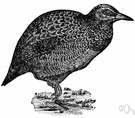weka
Also found in: Thesaurus, Acronyms, Wikipedia.
we·ka
(wē′kə, wā′-)n.
A flightless rail (Gallirallus australis) of New Zealand, having mottled brown plumage and short legs.
[Maori.]
American Heritage® Dictionary of the English Language, Fifth Edition. Copyright © 2016 by Houghton Mifflin Harcourt Publishing Company. Published by Houghton Mifflin Harcourt Publishing Company. All rights reserved.
weka
(ˈweɪkə; ˈwiːkə)n
(Animals) any flightless New Zealand rail of the genus Gallirallus, having a mottled brown plumage and rudimentary wings. Also: Māori hen or wood hen
[C19: from Māori, of imitative origin]
Collins English Dictionary – Complete and Unabridged, 12th Edition 2014 © HarperCollins Publishers 1991, 1994, 1998, 2000, 2003, 2006, 2007, 2009, 2011, 2014
ThesaurusAntonymsRelated WordsSynonymsLegend:
Switch to new thesaurus
| Noun | 1. |  weka - flightless New Zealand rail of thievish disposition having short wings each with a spur used in fighting weka - flightless New Zealand rail of thievish disposition having short wings each with a spur used in fightingrail - any of numerous widely distributed small wading birds of the family Rallidae having short wings and very long toes for running on soft mud Gallirallus, genus Gallirallus - rails of New Zealand |
Based on WordNet 3.0, Farlex clipart collection. © 2003-2012 Princeton University, Farlex Inc.